Composite Peripheral T-cell Lymphoma, Not Otherwise Specified and B-cell Small Lymphocytic Lymphoma Presenting with Hemophagocytic Lymphohistiocytosis
Ahmed Alomari, MD, Pei Hui, MD, Ph.D and Mina L. Xu, MD
Department of Pathology, Yale School of Medicine, New Haven, CT, USA
ABSTRACT
Context: Pre-analytical errors are detrimental to breast cancer (BC) molecular studies. To overcome such effects, a set of BC was analyzed to identify morphological signatures related to molecular phenotypes. Such signatures should trigger the need to repeat molecular testing whenever un-matched morphology/phenotype is encountered.
Design: 77 BC needle core biopsies and corresponding final excisions were randomly retrieved from our archival data from 2009 to 2011. Morphological features including tumor type (ductal/lobular), nuclear grade, tumor necrosis, lymphocytic response, stromal sclerosis, retraction artifacts, and lympho-vascular invasion were analyzed. ER, PR, and HER2 immunochemistry slides were scored. Epidemi-ological data and Her2 FISH results were captured from our database system. Surgical excisions with tumor grade and stage, lympho-vascular invasion, lymph node status, and metastasis were reviewed.
Results: Out of 77 cases, 72 (94%) were ductal and 5 (6%) lobular. 47 (61%) ER+ and 30 (39%) ER-. 38 (49%) PR+ and 39 (51%) PR-. 39 (51%) cases were HER2+ (Average age 59 years) while 38 (49%) were HER2- (Average age 67 years). HER2+ cases were more likely to have nuclear grade3 (p<0.0001), retraction artifacts (p=0.001) and mark-ed stromal sclerosis (p=0.04). A trend towards more nec-rosis in the HER2- cases was observed (p=0.18).
Conclusions: High nuclear grade, marked stromal scleros-is, and retraction artifacts could represent surrogate markers to HER2+ BC. Our results are in accordance to recent data relating extracellular matrix stiffness to tumor aggressive be-havior and need to be confirmed on larger samples.
©2012 Yale Department of Pathology. All rights reserved.
Any redistribution or reproduction of part or all of the contents in any form is prohibited. You may not, except with express written permission of the author or the Department of Pathology, distribute or commercially exploit the content, nor may you transmit it or store it in any other website or other form of electronic retrieval system, including use for educational purposes.
